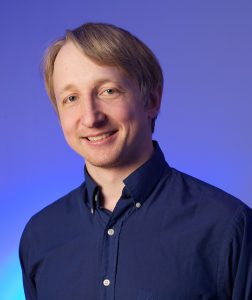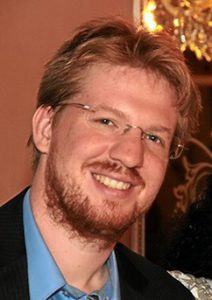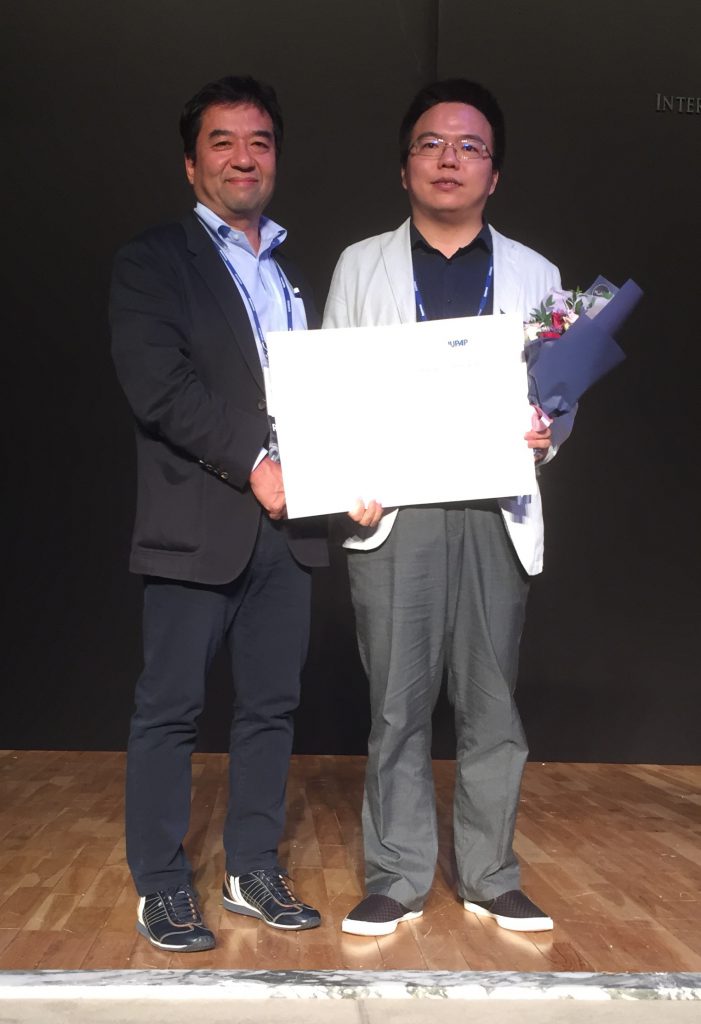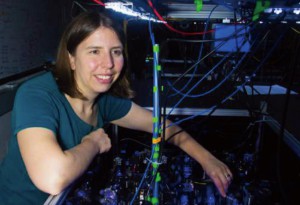
C15: News
IUPAP Young Scientist Prize in Atomic, Molecular and Optical Physics 2020
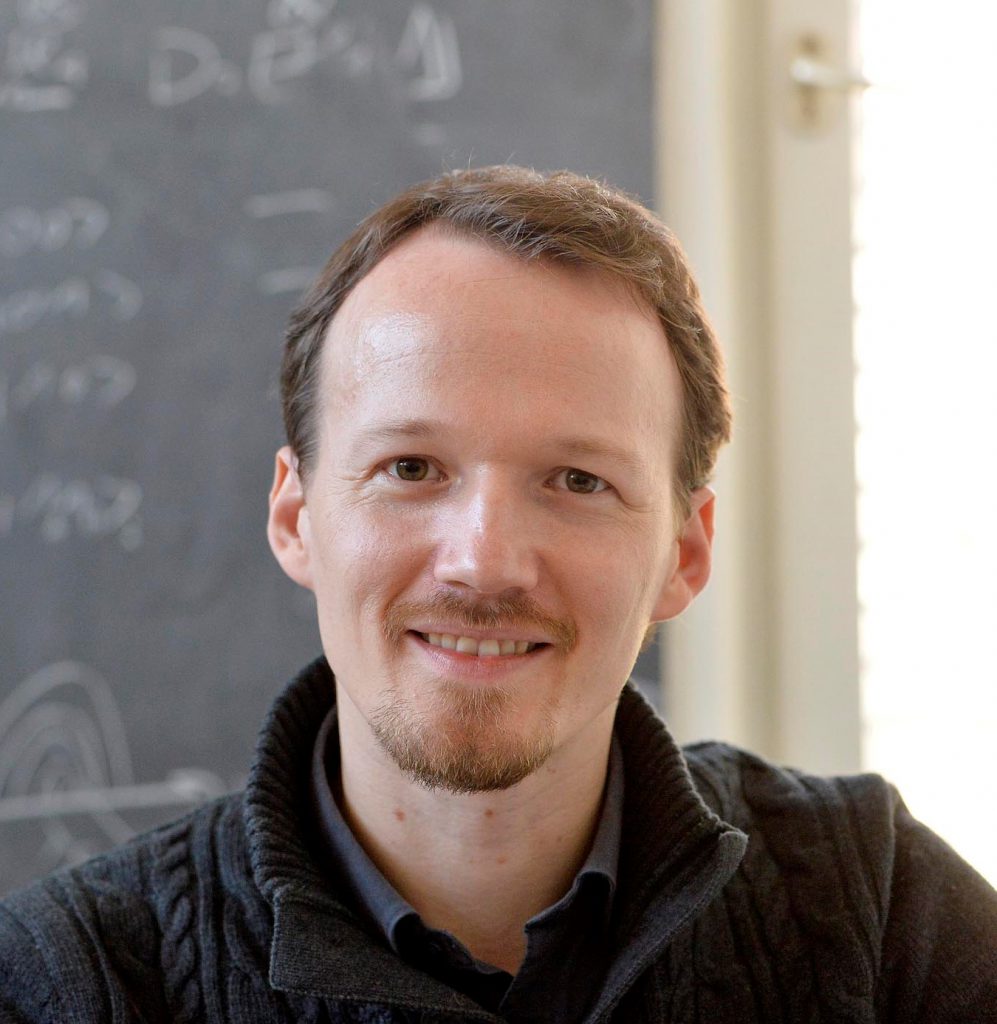
©AlessioCoser per UniTrento
Dr Philipp Hauke
“For his outstanding contributions to the development of quantum technologies based on Atomic, Molecular and Optical systems, ranging from quantum annealing, over quantum metrology, to quantum simulations of strongly-correlated condensed-matter systems and lattice gauge theories.”
Philipp Hauke received his PhD in 2013 from ICFO – The Institute of Photonic Sciences, Castelldefels, Barcelona. Afterwards, he held positions as University Assistant at the University of Innsbruck and as group leader at Heidelberg University. In fall 2019, he became Associate Professor at the INO-CNR BEC Center and the Physics Department of the University of Trento. His research focuses on developing the theoretical basis for novel quantum technologies. The vision is to harness the pristine control available in synthetic quantum systems such as cold atoms, trapped ions, superconducting qubits, or photonic devices for solving outstanding problems of practical relevance. Philipp Hauke’s group develops methods to characterize and measure entanglement as a quantum resource, derives algorithms to solve hard NP-complete problems through quantum annealing, and designs quantum simulations of strongly-correlated systems.
——————————————————————
IUPAP Young Scientist Prize in Atomic, Molecular and Optical Physics 2019
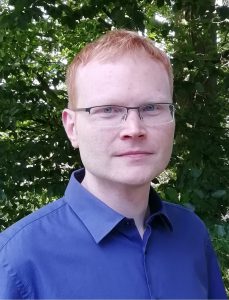 Dr Andreas Mooser
Dr Andreas Mooser
“For his outstanding contribution to determine the most precise comparison of the proton-to-antiproton charge-to-mass ratios and the most precise comparison of the proton and antiproton magnetic moments, constituting two different world-record tests of the fundamental charge, parity, and time reversal symmetry in these systems.”
Andreas Mooser received his Ph.D. in 2014 from the Johannes Gutenberg-University of Mainz for the first direct observation of single spin-transitions and the first direct high-precision measurement of the nuclear magnetic moment of a single proton. He received for his work the thesis award of the University of Mainz and GSI Darmstadt. Afterwards he obtained the highly competitive RIKEN FPR fellowship to join the BASE collaboration at CERN. Here he performed high-precision measurements of the fundamental properties of single protons and antiprotons, which culminated in the most precise tests of the CPT symmetry with protons and antiprotons to date. In parallel, he worked on the implementation of sympathetic laser cooling in Penning traps at the BASE-Mainz experiment and, together with researchers from the Max-Planck Institute for Nuclear Physics, Heidelberg, conducted the most precise measurement of the atomic mass of the proton. Since 2018, he joined the Max-Planck Institute for Nuclear Physics to lead a new research group, focusing on the high-precision measurements of the ground state hyperfine-splitting of single ionized 3He and the nuclear magnetic moment of the helion ion to investigate the nuclear structure of light atoms and establish a new standard for absolute magnetometry.
 Dr Christian Smorra
Dr Christian Smorra
“For his outstanding contribution to determine the most precise comparison of the proton-to-antiproton charge-to-mass ratios and the most precise comparison of the proton and antiproton magnetic moments, constituting two different world-record tests of the fundamental charge, parity, and time reversal symmetry in these systems.”
Christian Smorra graduated as PhD student in 2012 at the Ruprecht-Karls-University Heidelberg. As part of the “Cooled and Stored Ions Division” of the Max-Planck-Institute for Nuclear Physics, he measured the energy release of double-electron capture transitions with high precision using Penning trap mass spectrometry techniques. As RIKEN postdoctoral researcher, he joined the BASE collaboration at CERN to construct a new Penning-trap system for high-precision tests of CPT invariance with antiprotons. Here, he contributed to the development of the antiproton reservoir trap and to the most precise charge-to-mass ratio comparison of protons and antiprotons. He continued this work as CERN research follow, which resulted in a 350-times improved measurement of the antiproton magnetic moment. Currently, he is working at RIKEN on new methods to increase the sensitivity of low-energy antiproton measurements.
——————————————————————
IUPAP Young Scientist Prize in Atomic, Molecular and Optical Physics 2018
Dr Alexey Gorshkov
“For his outstanding contributions on quantum properties of interacting cold atoms, cold dipolar matter, quantum optics, quantum transduction, and quantum simulations.”
Alexey Gorshkov received his A.B. and Ph.D. degrees from Harvard in 2004 and 2010, respectively. In 2013, after three years as a Lee A. DuBridge Postdoctoral Scholar at Caltech, he became a staff physicist at NIST. At the same time, he started his own research group at the University of Maryland, where he is a fellow of the Joint Quantum Institute and of the Joint Center for Quantum Information and Computer Science. His theoretical research is at the interface of quantum optics, atomic physics, condensed matter physics, and quantum information science. One of the main long-term goals of his theoretical research group is to understand and control large interacting quantum systems, as well as to design and create new ones. Applications of his research include quantum computing, quantum communication, and quantum sensing.
——————————————————————
IUPAP Young Scientist Prize in Atomic, Molecular and Optical Physics 2017
Dr. Johannes Feist
Condensed Matter Physics Center (IFIMAC),
Universidad Autónoma de Madrid, Spain
‘For his outstanding contributions in modifications of molecular structure under strong light-matter coupling’.
Johannes Feist received his Ph.D. from Vienna University of Technology in 2009 and afterwards was awarded the ITAMP postdoctoral fellowship at the Institute for Theoretical Atomic, Molecular and Optical Physics (ITAMP) at the Harvard-Smithsonian Center for Astrophysics and Harvard University. In 2012 Johannes joined to the group of F. J. García Vidal as a senior postdoc at the Department of Theoretical Condensed Matter Physics at the Universidad Autónoma de Madrid, and in 2017, he started a tenure-track position as an IFIMAC Young Researcher at the Condensed Matter Physics Center (IFIMAC) in the same university.
His current research focuses on the influence of strong light-matter coupling on the properties of organic materials. In this regime, the interaction between transitions in emitters and confined light modes becomes strong enough that the elemental excitations of the system become hybridized light-matter states, so-called polaritons. This can lead to changes in material properties and even significantly modify chemical reactions. Johannes has made a number of significant contributions to this rapidly growing field, and in particular developed a theory combining molecular physics with cavity QED that can treat polaritonic chemistry by extending the concept of molecular potential energy surfaces to the strong-coupling regime. Based on this work, he has been able to show that nuclear motion in separate molecules could become correlated through their common interaction to a single light mode, as well as that photochemical reactions can be significantly suppressed or novel reaction channels opened under strong light-matter coupling with organic molecules.
—————————————————————
2016 IUPAP Young Scientist Prize
The 2016 Young Scientist Award for the Commission on Atomic, Molecular and Optical Physics (C15) was awarded to Dr. Yu-Ao Chen. The award was presented at the recent ICAP conference held in Seoul, Korea from July 24-29th, 2016. The Chair of C15, Dr. T. Azuma, presented the awards on behalf of the Commission.
Yu-Ao Chen received his Master’s degree from the University of Science and Technology of China (USTC) at Hefei (China) in 2004, and his doctorate from Heidelberg University (Germany) in 2008 under supervision of Prof. Jian-Wei Pan. After spending several years as postdoctoral researcher and project leader working with Prof. Immanuel Bloch in Germany, he returned back to USTC at Shanghai (China) as professor to start up his own group in 2011.
He covers a wide range of the field of AMO physics. He has carried out numerous outstanding achievements, namely multi-photon entanglement in quantum information processing, quantum memory toward long distance quantum communication, and recent works on quantum simulation with ultra-cold atoms in optical lattices.
He has been already awarded many prestigious prizes including the 2013 Fresnel Prize for fundamental aspects from the European Physical Society and the Qiu Shi Outstanding Youth Scholar in China.
————————————————
2015 IUPAP Young Scientist Prize
The 2015 IUPAP Young Scientist prize for the Commission on Atomic, Molecular and Optical Physics (C15) was awarded Dr Gretchen Campbell. It was presented at the conference ICPEAC held in 22-28 July 2015.
Gretchen K. Campbell, PhD
The 2015 IUPAP Young Scientist prize for the Commission on Atomic, Molecular and Optical Physics (C15) was awarded Dr Gretchen K Campbell, a Fellow, Joint Quantum Institute, National Institute of Standards and Technology and University of Maryland, Gaithersburg, MD. US, for her outstanding contributions in toroidal Bose-Einstein condensates and its application to “atomtronic” circuits.
She received her Ph.D. in Physics (87Rb Bose-Einstein Condensates in Optical Lattices) in 2007 from MIT, Boston under supervision of W. Ketterle and D. Pritchard. After a postdoc position at Prof. Jun Ye’s group at JILA/NIST, Boulder, she moved to JQI, NIST/Univ. of Maryland as a group leader of the Laser Cooling and Trapping group.
When BEC is held in a toroidal trap, one has quantized circulation around the ring, and the topology prevents the decay of the circulation. Such a system is the “atomtronic” atomic gas analog of a superconducting circuit or a liquid helium superfluid circuit. Campbell pioneered the study of ring-shaped Bose condensates of atomic gases and created the first closed-circuit atomtronic devices. She performed the ground-breaking experiments that incorporated a “circuit element” (a weak-link) into a closed loop of condensate.
After this milestone experiments, enormous progresses in this new research field have been achieved by her. For example, she created a design to make the weak link rotate around the ring, where the rotation rate is proportional to an applied magnetic field in the analog electrical circuit, which is essentially an rf SQUID. She found the crucial hysteretic effect in the changing of the circulation state. She also demonstrated that the circulating ring condensate interferes with a static reference condensate. This leads to interferometric measurement of the circulation state like the number of quantized circulations, the direction of circulation, and further the current-phase relationship of the weak-link.
The similarities and differences between Campbell’s atomtronic circuits and the equivalent electric circuits are thus bringing new insights into superfluidity and the controversial nature of critical velocities and the mechanisms for dissipation.
 IUPAP: The International Union of Pure and Applied Physics
IUPAP: The International Union of Pure and Applied Physics